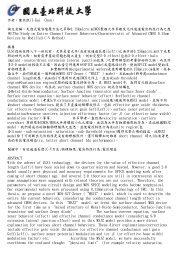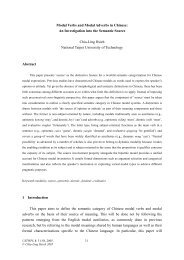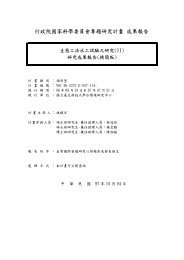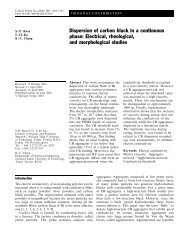A quasi-experimental study researching how a problem ... - NTUT IR
A quasi-experimental study researching how a problem ... - NTUT IR
A quasi-experimental study researching how a problem ... - NTUT IR
You also want an ePaper? Increase the reach of your titles
YUMPU automatically turns print PDFs into web optimized ePapers that Google loves.
World Transactions on Engineering and Technology Education © 2003 UICEE<br />
Vol.2, No.3, 2003<br />
A <strong>quasi</strong>-<strong>experimental</strong> <strong>study</strong> <strong>researching</strong> <strong>how</strong> a <strong>problem</strong>-solving teaching strategy<br />
impacts on learning outcomes for engineering students<br />
INTRODUCTION<br />
The <strong>problem</strong>-solving skill is an important intellectual activity<br />
for human beings; it is also a very important springhead of<br />
humankind’s knowledge [1]. Psychologists treat it as a<br />
complicated but highly structural progress of mental activities<br />
in human beings. The development of <strong>problem</strong>-solving skills is<br />
a main target in developed countries; it is also the core ability<br />
in engineering education [2]. In order to expand students’<br />
abilities in a specialised field, instructors should guide students<br />
to think, make decisions and apply knowledge to new settings.<br />
This will lead students to do <strong>problem</strong>-solving work smoothly,<br />
whether in or out of school.<br />
As a practical course, the teaching programme of the Power<br />
Wiring Course is a prescribed subject for students in the<br />
electric machinery field; it is also the most important module in<br />
the training programme. The teaching objective of this course is<br />
to let students become familiar with and understand the common<br />
uses of industrial wiring components and, furthermore,<br />
understand the basic theory of system control and the application<br />
of this basic theory to every kind of industrial control components<br />
[3]. Xu and Lai also pointed out that the Power Wiring Course<br />
was taken by students to develop their analysis and design<br />
abilities in industrial control circuits [4]. This would help<br />
students establish the concept and technique of the entire<br />
control system. As such, improving students’ <strong>problem</strong>-solving<br />
abilities in the Power Wiring Course is very important.<br />
Gagné considered <strong>problem</strong>-solving as a high-level deliberation<br />
ability that should have the following inherent conditions:<br />
• Arouse pre-preparing skills;<br />
• Interact with the contents of new studies in many different<br />
ways;<br />
• Apply new skills into different environments [5][6].<br />
Hsi-Chi Hsiao† & Jen-Chia Chang‡<br />
National Changhua University of Education, Changhua, Taiwan†<br />
National Taipei University of Technology, Taipei, Taiwan‡<br />
ABSTRACT: One of the major goals of engineering education is to cultivate students’ <strong>problem</strong>-solving abilities. However, current<br />
engineering education programmes have been criticised for not meeting such demand in this era of the knowledge economy.<br />
Traditionally, engineering students were taught using a lecture teaching method. Students majoring in various fields were asked to<br />
take different courses in order to graduate. They regarded themselves as competent in these fields, whether or not they learned <strong>how</strong> to<br />
face <strong>problem</strong>s. Therefore, the purpose of the article is to determine the effectiveness of a <strong>problem</strong>-solving teaching strategy on the<br />
learning outcomes of the Power Wiring Course (including <strong>problem</strong>-solving attitude and ability) for engineering students. Hopefully,<br />
the results of this <strong>study</strong> can be applied to engineering teaching to cultivate students’ <strong>problem</strong>-solving abilities. The <strong>quasi</strong><strong>experimental</strong><br />
unequal control group design was used in this <strong>study</strong>. The <strong>study</strong>’s major findings include significant increases in<br />
students’ <strong>problem</strong>-solving attitudes and abilities after implementing a <strong>problem</strong>-solving teaching strategy. Some recommendations in<br />
using <strong>problem</strong>-solving teaching strategies more effectively are also proposed for instructors in engineering education.<br />
391<br />
Gagné was of the view that, once the <strong>problem</strong>-solving skills are<br />
developed for students, students should also be set up for new<br />
settings. In addition to this, Cox deemed that during the<br />
<strong>problem</strong>-solving activities, knowledge in a specialised field is<br />
not enough for students, they also need the findings of the<br />
tactics of <strong>problem</strong>-solving, the foundation knowledge about<br />
<strong>problem</strong>-solving, and information in other related nonspecialised<br />
fields [3][7].<br />
Reaching a solution requires algorithms or heuristics [8]. An<br />
algorithm is a procedure that guarantees a solution, such as an<br />
algebraic formula. The drawback with the use of algorithms is<br />
that they are not available for every <strong>problem</strong>. Heuristics, on the<br />
other hand, do not have the limitations that algorithms have,<br />
although they may not provide the answer directly. Common<br />
heuristics methods incorporate: simplifying the <strong>problem</strong>;<br />
means-end analysis; working backwards; pattern recognition<br />
and trial and error [9].<br />
Taking on board Cox’s perspective, one can state that, in<br />
addition to domain-specific knowledge, <strong>problem</strong>-solving<br />
activity requires strategy to create <strong>problem</strong>s, a knowledge base<br />
of solvable <strong>problem</strong>s plus other additional information, such as<br />
domain free-knowledge. Following Cox’s ideas, supplemental<br />
teaching materials, including the above items, were developed<br />
for this <strong>experimental</strong> design <strong>study</strong>.<br />
A <strong>problem</strong>-solving teaching strategy is a teaching method that<br />
focuses not only on solving <strong>problem</strong>s, but on providing some<br />
supplemental instructional materials to cultivate students’<br />
independent thinking abilities, fact-finding abilities and<br />
scientific attitudes.<br />
In this <strong>study</strong>, a supplementary instructional unit, including ten<br />
units of Power Wiring: Basic Control Electrical Circuit was<br />
developed to construct students’ heuristics pertinent to
electrical circuit <strong>problem</strong> solving. The <strong>experimental</strong> group<br />
studied the supplementary instructional unit. This research<br />
focused on an analysis of the progress of electrical circuit<br />
troubleshooting in the Power Wiring Course, which requires<br />
that students develop skills in repair and replacement, diagnosis<br />
and testing, as well as application.<br />
PURPOSES<br />
Based on the aforesaid rationale and research background, the<br />
main purpose of this <strong>study</strong> was to understand the effect of a<br />
<strong>problem</strong>-solving teaching strategy on the development of<br />
<strong>problem</strong>-solving skills for engineering students in the Power<br />
Wiring Course. This research has the following objectives:<br />
• To compare differences in <strong>problem</strong>-solving attitude<br />
between the traditional teaching strategy and a <strong>problem</strong>solving<br />
teaching strategy on engineering students.<br />
• To compare the differences in <strong>problem</strong>-solving abilities<br />
between the traditional teaching strategy and a <strong>problem</strong>solving<br />
teaching strategy on engineering students.<br />
• According to the conclusions of the research, provide<br />
recommendations to improve <strong>problem</strong>-solving teaching<br />
strategies in engineering education and to develop<br />
students’ <strong>problem</strong>-solving abilities.<br />
METHOD<br />
The <strong>quasi</strong>-<strong>experimental</strong> research method was used in the <strong>study</strong><br />
to achieve the research purposes. The subjects were junior<br />
students of the Automatic Control Department at Taipei<br />
University of Technology, Taipei, Taiwan, and the<br />
<strong>experimental</strong> period was six weeks. Due to the organisational<br />
system of classes at the University, random sampling could not<br />
be utilised for the <strong>study</strong>. Under this condition, the <strong>quasi</strong><strong>experimental</strong><br />
design was used to obtain adequate control of<br />
sources of invalidity, and a non-equivalent control group design<br />
that did not involve the random assignment of each subject to<br />
groups was adopted [8]. The research design matrix is s<strong>how</strong>n in<br />
Table 1.<br />
Table 1: Mode of the experiment design.<br />
Experimental Controlled Total<br />
Male 37 37 74<br />
Female 5 2 7<br />
Total 42 39 81<br />
This research took the whole class as the random unit. Two<br />
existing classes were randomly assigned as either the<br />
<strong>experimental</strong> group or the control group. There were 42<br />
students in the <strong>experimental</strong> group and 39 students in the<br />
control group. The numbers of samples are s<strong>how</strong>n in Table 2.<br />
The framework of this <strong>study</strong> is s<strong>how</strong>n in Figure 1.<br />
Table 2: The distribution of the formal sample.<br />
Group Pre-test<br />
Experiment<br />
control<br />
Post-test<br />
Control Y3 · Y4<br />
Experimental Y1 X Y2<br />
These two groups were pre-tested, administered a treatment,<br />
and then post-tested. An advantage of this design is that since<br />
392<br />
classes are used as is, the possible effects from reactive<br />
arrangements are minimised. Indeed, subjects may not even be<br />
aware that they are involved in a <strong>study</strong>.<br />
Controlled<br />
variables<br />
Student character<br />
Intelligence<br />
Cognitive type<br />
Spatial ability<br />
Teacher character<br />
Teaching<br />
experience<br />
Specialised<br />
knowledge<br />
Materials<br />
Course contents<br />
Measurement tools<br />
Experimental<br />
variables<br />
Problem solving<br />
teaching strategy<br />
Supplementary<br />
teaching materials<br />
Figure 1: Framework of the research.<br />
Dependent<br />
variables<br />
Learning<br />
outcomes:<br />
1. Problem solving<br />
attitude;<br />
2. Problem solving<br />
ability;<br />
3. Academic<br />
achievement<br />
The progress of this <strong>study</strong> contained a literature review, the<br />
design of the teaching programme (including the development<br />
of teaching materials), the development of the scale of the<br />
<strong>problem</strong>-solving attitude, the development of the scale of the<br />
<strong>problem</strong>-solving ability, sample selection, pre-test,<br />
<strong>experimental</strong> teaching, post-test, the compilation of data, and<br />
the analysis of data. The <strong>experimental</strong> group and the control<br />
group used the same textbook and learned the same course<br />
contents. All students were from the same Department, and the<br />
instructor was the same. Possible attributes that could affect the<br />
<strong>study</strong>’s results were controlled to be as identical as possible.<br />
The administration of the experiment was based on whether the<br />
supplementary teaching materials were provided or not. The<br />
<strong>experimental</strong> group was provided with supplementary teaching<br />
materials, and the knowledge and skills needed to solve<br />
<strong>problem</strong>s were taught. But the control group was taught using<br />
the traditional teaching strategy without providing any further<br />
supplementary teaching materials except textbooks.<br />
Discussion on the dependent variables provided the differences<br />
between the <strong>experimental</strong> group and the control group in terms<br />
of the <strong>problem</strong>-solving attitude and ability.<br />
INSTRUMENT<br />
There are two instruments for the evaluation of the <strong>study</strong>. These<br />
include the scale of <strong>problem</strong>-solving attitude and the scale of<br />
<strong>problem</strong>-solving ability. The items for the scale of the <strong>problem</strong>solving<br />
attitude were compiled through three assumed factors,<br />
namely: the hesitated avoided style, the confidence of the<br />
<strong>problem</strong> solving and the control of the personality [10]. The<br />
validity of the scale was then established through factor<br />
analysis. Factor extraction was done through oblique rotation.<br />
Those items whose commonalities had Eigne values greater<br />
than one were retained. The results of factor analysis indicated<br />
that these three dimensions could explain 41.2% of the<br />
variance. The reliability of the scale of the <strong>problem</strong>-solving<br />
attitude was presented as the Cronbach α and the re-testing<br />
coefficient. The α coefficient was between 0.723 and 0.827 on








